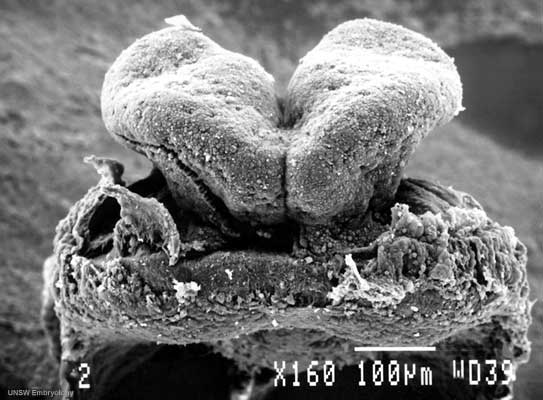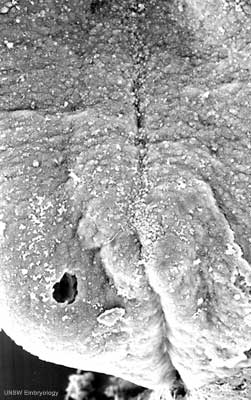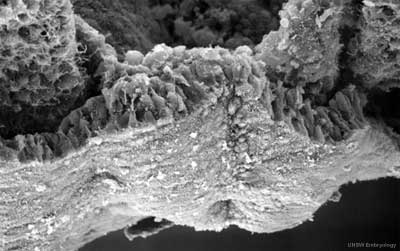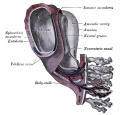Carnegie stage 9
| Embryology - 27 Apr 2024 |
|---|
| Google Translate - select your language from the list shown below (this will open a new external page) |
|
العربية | català | 中文 | 中國傳統的 | français | Deutsche | עִברִית | हिंदी | bahasa Indonesia | italiano | 日本語 | 한국어 | မြန်မာ | Pilipino | Polskie | português | ਪੰਜਾਬੀ ਦੇ | Română | русский | Español | Swahili | Svensk | ไทย | Türkçe | اردو | ייִדיש | Tiếng Việt These external translations are automated and may not be accurate. (More? About Translations) |
Introduction
Facts
Human embryonic stage 9 occurs during week 3 between 19 to 21 days.
Gestational Age GA - week 5
The embryo is now 1.5 to 2.5 mm in size and somites have begun to form and number between 1 to 3 somite pairs during this stage.
The initial images are displayed unlabeled to allow you to explore the embryo for yourself, linked labeled versions are also available for some images.
See also Carnegie stage 9 image gallery.
| Week: | 1 | 2 | 3 | 4 | 5 | 6 | 7 | 8 |
| Carnegie stage: | 1 2 3 4 | 5 6 | 7 8 9 | 10 11 12 13 | 14 15 | 16 17 | 18 19 | 20 21 22 23 |
- Carnegie Stages: 1 | 2 | 3 | 4 | 5 | 6 | 7 | 8 | 9 | 10 | 11 | 12 | 13 | 14 | 15 | 16 | 17 | 18 | 19 | 20 | 21 | 22 | 23 | About Stages | Timeline
Summary
- Ectoderm - Neural plate brain region continues to expand, neural plate begins folding over the notochord. Gastrulation continues through the primitive streak region.
- Mesoderm - Paraxial mesoderm segmentation into somites begins (1 - 3 somite pairs). Lateral plate mesoderm begins to vacuolate, dividing it into somatic and splanchnic mesoderm and to later form the intra-embryonic coelom. Prechordal splanchnic mesoderm begins to form the cardiogenic region, from which the primordial heart will develop.
- Endoderm - Notochordal plate still visible which will form the notochord. Endoderm is still widely open to the yolk sac and germ cells form part of this layer. Extra-embryonic mesoderm on the yolk sac surface begins to form "blood islands".
See also Events
Identify
- Neural groove and neural folds, the mesoderm, which segments beside the neural groove to form somites but extends laterally to margin of embryonic disc lateral plate mesoderm, where it merges with the covering extraembryonic mesoderm.
- The intra-embryonic coelom develops in the middle of the lateral plate mesoderm. Note amniotic ectoderm covered by extra-emebryonic mesoderm (empty spaces above and below the mesoderm are artefacts, as are the lateral folds in the ectoderm).
The first two images using bright field microscopy approximate the orientation of the scanning electron micrographs below. There are additional scanning electron micrographs showing selected features in detail. Carnegie_stage_9 image gallery
- Links: Week 3 | Gastrulation | Lecture | Practical | 1920 Carnegie No.1878 | Stage 10
Bright Field Lateral
| Lateral View | Ventrolateral View |
|---|---|
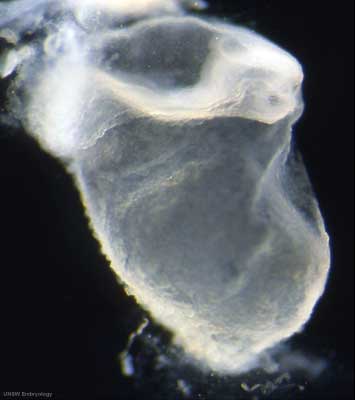
|
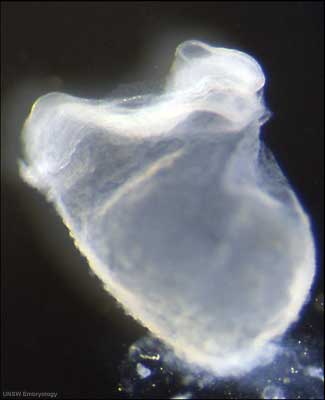
|
| Lateral View 1 - Large | 800px | Medium | Small | Ventrolateral View 2 - Large | 800px | Medium | Small |
Scanning EM Lateral
| Lateral View | Ventrolateral View |
|---|---|

|
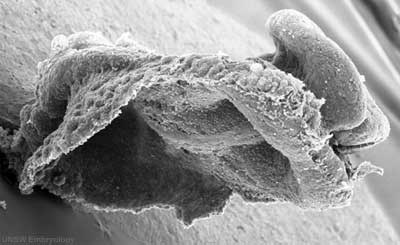
|
| Lateral View 1 - Small | Medium | Large | Ventrolateral View 2 - Small | Medium | Large |
Notochordal plate
Notochordal plate - Small | Medium | Large
Bright Field Dorsal
| Dorsal | Ventral |
|---|---|
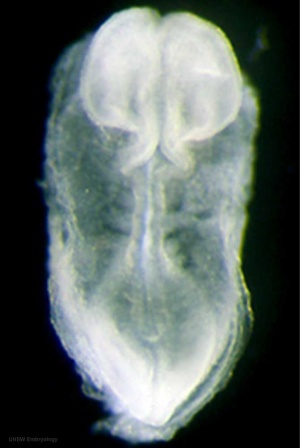
|

|
| Lateral View 1 - Small | Medium | Large | Ventrolateral View 2 - Small | Medium | Large |
Scanning EM Dorsal
Kyoto Collection
| Dorsal View | Ventral View |
|---|---|

|

|
| Embryonic disc, showing the epiblast viewed from the amniotic (dorsal) side. | Embryonic disc, showing the epiblast, connecting stalk and brain fold. |
Image source: UNSW Embryology page Created: 19.03.1999
Image source: The Kyoto Collection images are reproduced with the permission of Prof. Kohei Shiota and Prof. Shigehito Yamada, Anatomy and Developmental Biology, Kyoto University Graduate School of Medicine, Kyoto, Japan for educational purposes only and cannot be reproduced electronically or in writing without permission.
Carnegie Collection
| Carnegie Collection - Stage 9 | ||||||||||
|---|---|---|---|---|---|---|---|---|---|---|
| Serial No. | Pairs of somites | Size (mm) | Grade | Fixative | Embedding Medium | Plane | Thinness (µm) | Stain | Year | Notes |
| 1878 | 2-3 | Embryo, 1.38 Ch., 12x10.5x7.5 |
Good | Formalin | P | Coronal | 10 | (Stain - Haematoxylin Eosin) | 1917 | Described by Ingalls (1920).[1] |
| 5080 | 1 | Embryo, 1.5 Ch., 14.5 |
Poor | Formalin | P | Transverse | 10 | Al. coch. | 1926 | Studied by Davis (1927).[2] |
| 7650 | 2-3 | Embryo, 2-3 | Good | Alc & Bouin | C-P | Transverse | 6 | (Stain - Haematoxylin Eosin) | 1939 | Said to be female[3] |
Abbreviations
| ||||||||||
References
| ||||||||||
| iBook - Carnegie Embryos | |
|---|---|
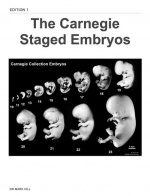
|
|
Events
References
- ↑ Bartelmez GW. The origin of the otic and optic primordia in man. (1922) J. Comp. Neural., 34: 201-232.
- ↑ Ingalls NW. A human embryo at the beginning of segmentation, with special reference to the vascular system. (1920) Contrib. Embryol., Carnegie Inst. Wash. Publ. 274, 11: 61-90.
Additional Images
Primordial germ cell region
Light Images
Scanning EM Images
SEM Dorsal
SEM Cranial Neural fold
SEM Caudal Region
SEM Caudal Region cross section
Image Source: Scanning electron micrographs of the Carnegie stages of the early human embryos are reproduced with the permission of Prof Kathy Sulik, from embryos collected by Dr. Vekemans and Tania Attié-Bitach. Images are for educational purposes only and cannot be reproduced electronically or in writing without permission.
Historic Stage 9 Embryos
Listed by number of pairs of somites.
1 somite Carnegie No. 5080. Studied and illustrated by Davis (1927, figs. 2–5 and 39–42) and Severn (1971, figs. 1–4). First pair of somites not separate rostrally and contain no myocoeles (Arey, 1938). Chorion, 14.5 x 1.5 mm. Embryonic disc, 1.5 mm. Reconstructed by Müller and O'Rahilly (1983, fig. 2).
1 somite A specimen described briefly by Baginski and Borsuk (1967).
1-2 somite (or more?), Carnegie No. 7650. Reconstructed by Müller and O'Rahilly (1983, fig. 5).
2 somites, Da 1 (Dann). An important specimen (fig. 9-2) possessing 2 pairs of somites (Studnicka, 1929; Florian and Völker, 1929; Arey, 1938)[1], although featured originally as having only one. Described and illustrated in detail by Ludwig (1928). Removed from uterus. Chorion, 12 mm. Embryo, 1.8 mm in a straight line, 2.4 mm by flexible scale. Sectioned transversely at 8 μm. Stained with alum cochineal. Neurenteric canal present. Sections are housed in the Anatomisches Institut, Basel. Photographs of sections are in Carnegie Collection under No. 5982. Presumed age, about 21 days. Dorsal and median projections published (ibid., figs. 1 and 2; Florian and Völker, 1929, fig. 14). Reconstructed by Müller and O’Rahilly (1983) fig. 3.
2–3 somites, H3. Described by Wilson (1914)[2], according to whom it “possessed probably two, possibly three, pairs of somites.” Chorion, 8.5 x 5.7 x 5 mm. Embryo, 1.43 mm. Sectioned obliquely (transversely) at 10 μm. Stained with hematoxylin. Fixation not adequate for reconstruction. The relatively longer primitive streak suggests that this embryo may be less advanced than No. 1878. Prechordal plate, or at least prechordal mesoderm, figured (Hill and Florian, 1931b)[3]. Presumed age, 18–21 days.
2/3 somites, Carnegie No. 1878 (figs. 9-3 to 9-7). An important specimen possessing 2 somites on the right side and 3 on the left. Florian (1934b) had certain difficulties and considered the embryo to be too small. Curettage. Chorion, 12 X 10.5 X 7.5 mm. Embryonic disc, 1.38 mm in a straight line. Described in detail and illustrated by Ingalls (1920)[4] who believed that “the earliest recognizable stage of dextrocardia” is present, “to which might have been added later a more or less complete situs inversus viscerum”; at any rate, Davis (1927), who studied and illustrated the heart, considered that “the cardiac area is distorted.” Angiogenesis in chorion described by Hertig (1935). Primitive streak and node, 0.13 mm, according to Ingalls, but about 0.22 mm in fig. 15 of Florian and Völker (1929) and more than 0.3 mm in plate 5, fig. 9, of Bartelmez and Evans (1926)[5]. Neurenteric canal not patent but pit present (Bartelmez and Evans, 1926)[5]. Median projection published (ibid., plate 5, fig. 9; Florian and Völker, 1929, fig. 15; Müller and O’Rahilly, 1983, fig. 1).
3 somites, T439 (Toronto). Possesses 3 pairs of somites (Arey, 1938), although considered originally as having only 2. Described by Piersol (1939). Embryo (along surface), 2.03 x 0.72 mm. Sectioned sagitally. Neurenteric canal closed but its remains are identifiable. Primordial germ cells near allantois. Embryonic disc rostral to somites, including cardiac area, is retarded. Said to contain no blood vessels in any part of the embryo itself.
3 somites, Vant embryo. Described by Shaner (1945)[6], who found “two to three pairs of somites.” Embryo (along curve), 1.5 mm. Thought to be 25 ± 2 days. Reconstructed again from original sections by Müller and O’Rahilly (1983, fig. 4).
3 somites, Gv (Madrid). Described by Jiménez Collado and Ruano Gil (1963). Heart described by Orts Llorca, Jiménez Collado, and Ruano Gil (1960). Tubal. Embryo, 1.81 mm. Sectioned at 7 μm. Stained with hematoxylin and eosin. Reconstructed. On the basis of its external characters, said to lie between stage 9 and stage 10. Presumed age, 21 ± 1 days.
3 somites, No. 2008 (Prague). Excellent specimen (figs. 9-8 to 9-14) belonging to Dr. J. E. Jirásek. Embryo, 1.73 mm. Fixed in calcium formol. Sectioned transversely at 10 μm. Various stains used, including histochemical procedures. Should be published.
3 somites (?), His embryo E. This 2.1-mm specimen is listed by Bartelmez and Evans (1926)[5] between No. 1878 (2–3 somitic pairs) and No. 3709 (4 somitic pairs, stage 10).
References
- ↑ Arey LB. The history of the first somite in human embryos. (1938) Contrib. Embryol., Carnegie Inst. Wash. Publ. 496, 27: 233-269.
- ↑ Wilson JT. Observations upon young human embryos. (1914) J Anat Physiol., 48(3): 315-51 PMID 17233002 PMC1288949
- ↑ Hill JP. and Florian J. A young human embryo (embryo dobbin) with head-process and prochordal plate. (1931) Phil. Tran. Roy. Soc. London B, 219: 443-486.
- ↑ Ingalls NW. A human embryo at the beginning of segmentation, with special reference to the vascular system. (1920) Contrib. Embryol., Carnegie Inst. Wash. Publ. 274, 11: 61-90.
- ↑ 5.0 5.1 5.2 Bartelmez GW. and Evans HM. Development of the human embryo during the period of somite formation, including embryos with 2 to 16 pairs of somites. (1926) Contrib. Embryol., Carnegie Inst. Wash. Publ. 362, 17: 1-67.
- ↑ Shaner RF. A human embryo of two to three pairs of somites. (1945) Canad. J. Res. 23: 235-243.
Historic Images
| Historic Disclaimer - information about historic embryology pages |
|---|
| Pages where the terms "Historic" (textbooks, papers, people, recommendations) appear on this site, and sections within pages where this disclaimer appears, indicate that the content and scientific understanding are specific to the time of publication. This means that while some scientific descriptions are still accurate, the terminology and interpretation of the developmental mechanisms reflect the understanding at the time of original publication and those of the preceding periods, these terms, interpretations and recommendations may not reflect our current scientific understanding. (More? Embryology History | Historic Embryology Papers) |
Ingalls NW. A human embryo at the beginning of segmentation, with special reference to the vascular system. (1920) Contrib. Embryol., Carnegie Inst. Wash. Publ. 274, 11: 61-90.
Shaner RF. A human embryo of two to three pairs of somites. (1945) Canad. J. Res. 23: 235-243.
- Carnegie Stages: 1 | 2 | 3 | 4 | 5 | 6 | 7 | 8 | 9 | 10 | 11 | 12 | 13 | 14 | 15 | 16 | 17 | 18 | 19 | 20 | 21 | 22 | 23 | About Stages | Timeline
Cite this page: Hill, M.A. (2024, April 27) Embryology Carnegie stage 9. Retrieved from https://embryology.med.unsw.edu.au/embryology/index.php/Carnegie_stage_9
- © Dr Mark Hill 2024, UNSW Embryology ISBN: 978 0 7334 2609 4 - UNSW CRICOS Provider Code No. 00098G



